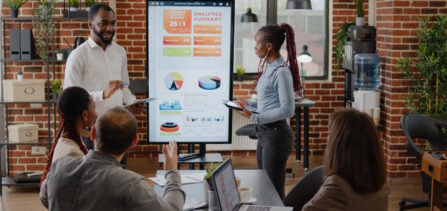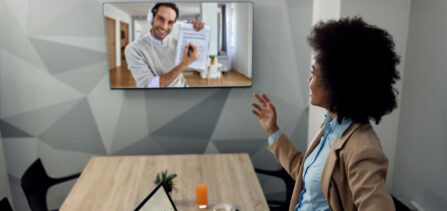
Presentation Tips: How to Use Eye Contact
Are you capitalising on the simplest way to boost the impact of your presentations?
Presentation Tips: How to Use Eye Contact for Connection
No advice on presentation tips would be complete without the importance of eye contact. Watching a presenter reading their notes aloud or talking to their slides can diminish your interest in a subject, and can even make you feel like you don’t really need to be there.
Eye contact aids communication because it creates a direct connection. Without it, communication becomes harder and has less impact. Eye contact keeps people awake.
There are hundreds of articles on the benefits of making eye contact during presentations. As one of the most fundamental presentation tips, eye contact helps you convey subjects with authority, and makes audience members feel like participants rather than observers.
Eye contact also improves your concentration and eases anxiety because it reminds you that audience members are individuals like yourself rather than a faceless group of critics.
There are fewer articles on how to use eye contact, so here are some simple presentation tips that will improve the way you connect with audiences. They reinforce our seven laws of presentation skills.
Keep Your Eyes on the Move
As you present, make eye contact with as many members of the audience as possible. With larger audiences, try to make eye contact with everyone at least once. With smaller audiences, try to balance the level of eye contact between participants. By doing so, your audience will feel that you are addressing them as individuals and that your messages are personal.
Aim for Three to Five Seconds
Ideally, stick to between three to five seconds of eye contact before moving on to the next person. However, avoid counting the seconds in your mind as this can break your concentration, which may diminish your presentation performance.
As with all presentation tips, practice is essential. When you run through the presentation on your own, move your eyes every three to five seconds to look at a different point in the room. This will help to make eye contact an organic part of your authentic presentation style.
Naturally, bear in mind that there are a few situations where you need to lock eye contact for longer. For example, when listening to someone’s question or while asking them a follow-up question.
Keep the Rhythm
Regularly switch eye contact with different members of the audience so no one feels singled out by lengthy periods of staring. Even when referencing the work of someone in the room, you only need to catch their eye as you begin to mention them, before moving on to connect with others.
Eye contact also goes hand in hand with another extremely valuable presentation training technique: The Well-Timed Pause.
Keep it Random
Make your moment-to-moment targets for eye contact seem perfectly natural rather than a systematic pattern. A useful acting technique is to mentally split the audience into three groups from left to right. For example, you might look ‘audience left’ for a bit to make eye contact with two or three people. Then look ‘audience right’ and make eye contact with two or three more, before focusing on ‘audience centre.’
If you are standing, then move around the speaking area to make your eye contact look even more organic. Moving while you speak is one of our top presentation tips for Speaking with Confidence.
Observe Reactions
Another key benefit of eye contact is that it lets you see how the audience is reacting to what you say. Although they are sitting still and silently, look for nods, frowns, and anyone who seems a little confused or bored.
Using eye contact to gauge reactions gives you the opportunity to tailor your presentation to the audience, such as explaining a point in greater detail than you originally intended.
Answer Questions to the Room
When answering questions, never run the risk of the rest of the audience feeling left out. Lock eyes with the person as they ask their question, and then deliver your answer to the room so everyone gains the benefit of the knowledge.
It also helps to repeat the question back to the room before you answer, which ensures everyone understands the context. This is just one of our valuable presentation techniques that will help you host a perfect Q&A session.
Presentation Tips: How to Use Eye Contact
Impact Factory runs
Open Presentation Skills Courses
Tailored Presentation Training
Five-Day Elite Presentation With Impact Workshops
and personalised
One-to-One Executive Presentation Coaching
for anyone who is interested in
Presentation Tips




